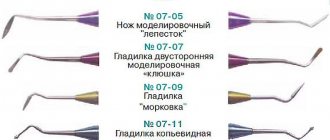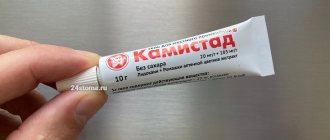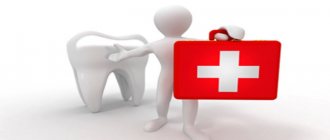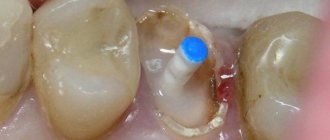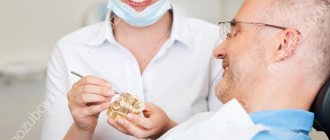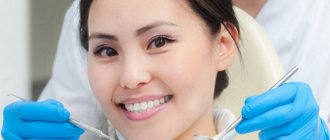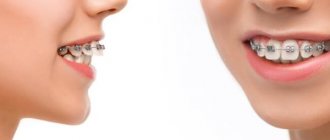decay is a dental disease that can develop for many reasons. It is not always the fault of poor hygiene, so it is extremely important to identify it as early as possible to prevent the infection from spreading to the nerve and beyond the tooth. The earliest stage of caries - the spot stage - is often completely reversible, but the experience of doctors shows that such caries is more often detected during a preventive examination, and not by the patient himself.
Non-carious diseases can develop for various reasons: excess fluoride in water, taking various medications, poor diet, bad habits, congenital characteristics of teeth, unfortunate accidents (in case of injuries).
What is therapeutic dentistry?
There are many different areas of dental practice. Therapeutic dentistry is a fundamental area whose objectives are to treat diseases of the teeth and periodontal tissues.
Services provided by therapeutic dentistry:
- treatment of dental caries and any of its complications (pulpitis, periodontitis);
- treatment of gum inflammation (gingivitis, periodontitis);
- treatment of non-carious enamel lesions (fluorosis, hypoplasia, erosion);
- treatment and restoration of teeth after injury;
- elimination of birth defects of shape or color.
The methods of modern therapeutic dentistry are aimed at preserving teeth and eliminating factors that can lead to its destruction.
Problematic teeth are not a problem for the specialists of the PROFI-Dent clinic!
Using modern technologies, our experienced doctors will carry out a completely painless set of procedures and quickly restore your teeth to health, and you to a great mood.
The PROFI-Dent dental therapy room is equipped with everything necessary to make patients feel as comfortable and safe as possible.
Do you dream of healthy, snow-white teeth? Our clinic uses a wide range of procedures and measures aimed at restoring the natural attractiveness of teeth:
Filling and remineralization
Crowns and inlays
All types of whitening
Aesthetic restoration and others
High-quality materials of the latest generation, which are used in our therapeutic dentistry in Moscow, allow us to achieve excellent results while maintaining the full functionality of the dentition.
What does a dental therapist do?
Within the competence of a dentist-therapist is the treatment of major dental diseases. A dental therapist does the following:
- conducts an initial consultation;
- performs an examination and, if necessary, refers the patient to hardware diagnostics (X-ray, orthopantomogram, CT);
- makes a diagnosis;
- draws up a treatment plan;
- provides treatment for caries and other dental diseases;
- performs fillings and direct restoration of teeth;
- carries out professional oral hygiene;
- eliminates cosmetic defects of teeth, carries out whitening procedures in dentistry;
- carries out other preventive procedures (remineralization, fluoridation, etc.)
As a rule, a dental therapist also specializes in endodontic treatment, and performs cleaning and root canal treatment.
Symptoms that may indicate the need for dental treatment
If you are worried about tooth pain, even if it is mild and appears from time to time, this is a clear reason to see a doctor and undergo professional dental treatment. The sooner you contact a specialist, the less likely it is that the treatment will be complex, protracted and painful. The following symptoms may also indicate the need for urgent dental treatment: The appearance of dental hypersensitivity; sharp, unpleasant odor from the mouth (if hygienic procedures for caring for the oral cavity are carried out on an ongoing basis); bleeding, swelling of gum tissue; problems with opening/closing the mouth; the appearance of spots, irregularities on the dental surfaces, and changes in the shade of tooth enamel. Remember that a timely visit to the dentist for tooth treatment is the only way to save the tooth. And your teeth are better than any, the most modern dentures!
Modern methods of therapeutic treatment in dentistry
Therapeutic treatment in dentistry includes a whole range of procedures, including diagnostics, filling, and removal of dental plaque on the teeth. For any problem, modern dentistry has several solutions.
Diagnostics in therapeutic dentistry
When a simple visual examination of the oral cavity is not enough to accurately make a diagnosis, identify the source of inflammation, or assess the nature of the pathology, the dentist-therapist prescribes hardware dental diagnostics to the patient.
The following types of hardware diagnostics are used in therapeutic dentistry:
- targeted x-ray – pinpoint identification and confirmation of the problem, monitoring treatment results;
- orthopantomogram - a panoramic image, effective in studying difficult-to-diagnose cervical caries, with multiple caries, gives an idea of the condition of all teeth of both jaws;
- CT is a method that provides the most detailed display of the condition of the teeth, the structural features of the root canals, the condition of the periodontal tissues, bite, and helps to identify any pathologies of the dental system.
Dental treatment
The most common dental disease that a dentist has to deal with is caries. The cause of caries can be poor hygiene, internal diseases, mineral deficiency in the body and many other factors. The danger of caries is that up to a certain point it develops without obvious symptoms, and it can only be detected during a dental examination, where the doctor uses a special instrument.
Therapeutic dentistry today can offer patients the most effective methods of treating and preventing infection. Traditional treatment of caries is carried out in several stages:
- 1
Examination, pathology analysis, assessment of the size of the carious cavity, drawing up a treatment plan. - 2
According to indications (in case of hypersensitivity, deep cavity), the doctor applies local anesthesia.
- 3
Preparing the tooth, removing infected dentin, forming a cavity and preparing it for filling.
- 4
Filling (restoration).
- 5
Final processing of the restoration (giving an anatomically correct shape, occlusion control, polishing).
In case of complications (pulpitis), cleaning, sterilization, treatment and sealing of the root canals are also carried out.
In addition to traditional filling, there is also a method of non-invasive treatment of caries at the initial stage (when the infection has affected only the surface enamel layer of the tooth) - ICON. This method is absolutely painless, is successfully used in adult and pediatric dentistry, and allows treatment without damaging healthy tooth tissue.
Gum treatment
Treatment of gums in a therapeutic dentistry office is carried out with a slight development of the inflammatory process and involves the following measures:
- removal of dental plaque, professional oral hygiene;
- elimination of factors that create favorable conditions for the development of infection in gingival tissues - treatment of caries, replacement of old restorations;
- treatment of inflamed tissues with special antibacterial agents (applications, application of medicinal gels);
- prescribing a course of drug therapy;
- consultation on home oral hygiene, prevention of gingivitis.
In case of serious damage to the gums (development of periodontitis, formation of periodontal pockets, tooth mobility, etc.), treatment is carried out by specialists from other branches of dentistry - a periodontist, a dental surgeon.
Prevention
The main cause of dental and gum disease in patients is dental plaque and tartar. Therefore, one of the best methods for preventing caries and gingivitis is professional oral hygiene in dentistry.
If there is a high predisposition to the development of caries (weak enamel), before orthodontic treatment, as a preventative measure, the doctor may prescribe the patient enamel remineralization (nutrition with minerals, strengthening of hard tissues, protection from destruction by infection).
Teeth whitening
Professional whitening effectively removes unaesthetic pigments of yellow, gray, brown shades on teeth. Modern technologies make it possible to carry out whitening without pain, without the risk of damaging the enamel.
How is the diagnosis made?
Of course, different diseases require different diagnostic procedures and treatment. Sometimes major surgery may be required, and sometimes minor intervention may be enough. How is caries detected? For this, a temperature diagnostic method can be used, that is, the presence of a tooth reaction to cold or, conversely, hot food. The more accurately the reaction is assessed, the more accurate the diagnosis will be made. As a result, the patient may have the initial stage of carious lesions, tissue inflammation, or pulpitis - a deep cavity inside the tooth.
Another diagnostic method involves the use of an electrical discharge. This technology is called electroodontodiagnostics and is suitable for identifying increased sensitivity of tissues to any external influence.
Therapeutic dentistry also resorts to chemical research. To do this, samples of material are taken from the site of the disease, after which they are examined for the presence of a nutrient medium. If the chemical reaction is positive, a course of treatment is prescribed. This method allows you to prevent severe consequences of pathology in the future.
Principles of therapeutic dental treatment at the Amel Dental clinic
- safety of all procedures;
- treatment without pain and without complications;
- desire to preserve teeth;
- the use of the most gentle treatment methods to minimize intervention and prolong the life of teeth;
- caring for the health and beauty of your smile.
Innovative technologies (modern stoma equipment, dental microscope), dental materials and medications of the highest quality help us guarantee such treatment results. We use digital technologies in diagnostics and treatment, which allows our doctors to make an accurate diagnosis, control all processes, avoid errors and guarantee patients high quality dental services.
Materials and technologies
Therapeutic treatment at the PROFI-Dent clinic involves a holistic approach to the problem, which allows us to be one step ahead and makes visiting the dentist as comfortable as possible. Many dental problems that previously led to the unequivocal removal of the affected tooth are today resolved completely differently.
In our clinic, therapeutic dental treatment is carried out using advanced dental technologies.
We use only the latest filling materials (composites), which allow us to restore the anatomical and aesthetic components of the tooth down to the smallest detail and literally make your smile impeccable in just a few minutes.
FAQ
What is therapeutic dentistry?
This is a branch of dentistry that deals with the study, diagnosis, treatment and prevention of diseases of the teeth, tissues surrounding the tooth, and the oral mucosa.
Which doctor treats caries?
The dentist-therapist deals with the treatment of caries, as well as the treatment of non-carious lesions of teeth.
What does a dental therapist treat?
A dentist treats caries, gingivitis, non-carious damage to teeth, fills teeth, restores teeth after injury (chips, fractures), corrects cosmetic defects using direct restoration, treats diseases of the gums and mucous membranes, gives recommendations on the prevention of dental diseases and proper hygiene.
Cost of orthopedic dentist services
We value each of our patients, so our prices for therapeutic dental treatment are among the lowest in Moscow. Just compare our price list with similar offers and see for yourself.
| Price list for dental | |
| Consultation with a dentist-therapist | FOR FREE |
| Treatment of caries | from 4,000 rubles |
| Treatment of pulpitis | from 6,500 – 13,000 rubles |
| Treatment of periodontitis | from 8,000 – 16,000 rubles |
| Application anesthesia | 100 rubles |
| Laser analgesia | 800 rubles |
| Injection anesthesia | from 500 rubles |
| Removing the seal | 200 rubles |
| Temporary filling | 250 rubles |
| Treatment of herpes (1 lesion) | 400 rubles |
| Treatment of aphthous stomatitis | 400 rubles |
| Treatment of angular cheilitis | 400 rubles |
| Treatment of hyperesthesia (1 tooth) | 500 rubles |
| Treatment of TMJ diseases (1 procedure) | 1,000 rubles |
| Biostimulation (1 procedure) | 1,000 rubles |
| Treatment of leukoplakia | 2,300 rubles |
Complications after treatment
Depending on the complexity of the clinical case, the individual sensitivity of the patient’s tissues to manipulations and medications, and other factors, some complications may be observed in the immediate aftermath of treatment.
- Painful sensations. Can last up to several days. As a rule, they go away on their own. For severe pain, it is recommended to take an analgesic.
- Swelling of the gums and cheeks. Can be stored for 1–2 days. Additional measures - rinsing (in consultation with your doctor).
- Sensation of loose closure of opposing teeth. If it persists for several days, you should contact your dentist; additional polishing of the filling may be required.
The occurrence of complications such as infection, insufficiently sealed canals, and others is currently rare.

